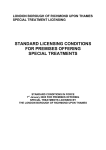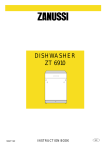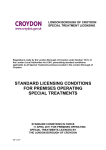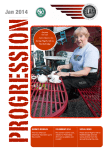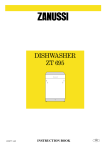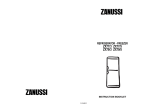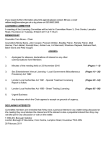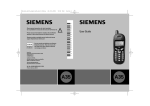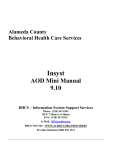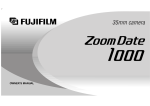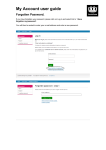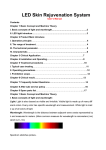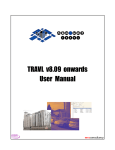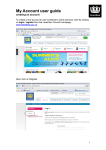Download Special treatment licence application
Transcript
London Local Authorities Act 1991 – Special Treatment Licence Application for the Grant* / Renewal* / Variation* *please circle as appropriate I/We hereby apply to the London Borough of Hounslow for the premises named in Section 2 of this form to be licensed for Special Treatments under the above Act. Please fully complete each section Section 1: Details of premises where special treatments will be conducted. Trading name of premises Manager: Forename (s) Surname Maiden Name Trading Address of premises to be licensed Town Postcode Telephone no. Name of Company / Partnership: Address (Registered / Head Office) Town Postcode Telephone no Section 2: Personal details of applicant Forename (s) Surname Maiden name Private address Town Age Postcode NI No. Telephone no. Male / Female_____________ Technical qualifications (e.g. BTEC) Training establishment Section 3: Other Establishments Only complete this section if the applicant is, or has been, employed/self-employed/had an interest in any other special treatment premises in the last five years. Address of premises……………………………………………………………………………….. ……………………………………………………………………………………………………….. Nature of Interest…………………………………………………………………………………… Section 4: Special Treatments Circle all special treatments carried out: Category 1 Laser, Intense Pulse Light. Category 2 Acupressure, Acupuncture, Aromatherapy, Body-piercing, Massage, Semi-permanent make-up, Shiatsu, Tattooing. Category 3 Facial Treatments, Chiropody, Electrolysis, Floatation, Reflexology, Sauna, Sunbeds, Category 4 Manicure, Pedicure, Ear-piercing, Nose-piercing. Other - .................................................................................................................................. Please specify. Please check with the licensing authority if you are unsure of the fee. Applications received with no fee or the wrong fee may be returned, which may mean that activities must cease at the premises to be licensed until such time as the application has been processed Please note an application for a specific category will include permission to conduct activities in a lower category provided that appropriate details, including necessary qualifications for the therapists / technicians are included in this application. Only activities applied for will be permitted on any licence granted. Section 5: Persons providing treatments Enclose ‘Originals’ of all qualification certificates in relation to employees, two full-face passport size photos must be provided annually of each individual listed below. Please ensure the names of the employees are ‘Printed’ clearly on the back of each photograph. All overseas qualifications must be verified by UK NARIC. PLEASE NOTE – RENEWAL APPLICANTS WILL NOT BE REQUIRED TO SUBMIT ANY QUALIFICATIONS UNLESS THEY CARRY OUT NEW TREATMENTS THAT THEIR QUALIFICATIONS DO NOT IDENTIFY AND AS SUCH REQUIRE FORMAL TRAINING. ALL NEW PRACTITIONERS QUALIFICATIONS MUST BE PROVIDED PRIOR TO THEM PROVIDING ANY TREATMENTS. THEIR QUALIFCATIONS WILL ONLY BE ACCEPTED AS SUITABLE WHERE THE TRAINING HAS BEEN PROVIDED BY THOSE PROVIDERS IDENTIFIED THROUGH THE LIST OF ACCREDDITTED TRAINING BODIES HELD BY THE COUNCIL. THIS LIST IS AVAILBLE UPON REQUEST. Full Name (inc. maiden name) Qualification (s) Name and address of Training Establishment Period of Study From Please continue on a separate sheet if required. To Date exams passed Section 6: Description of Premises Please describe the premises Please describe the type of lighting on the premises How will the premises be heated? In the case of fire, how do you get out? The basement (if any) The ground floor The upper floors Please describe the number and types of fire extinguishers and fire blankets you have on the premises. What will be the highest number of people (including staff) on the premises at any one time? What is the number of toilets on the premises? Section 7: Special treatments to be licensed (in detail) IMPORTANT- All electrical equipment used within the terms of this licence must be certified as to its safety not less than once in every period of 12 months, or no longer periods as may be recommended by an electrical contractor, whose name is on the roll of the National Inspection Council for Electrical Installation Contracting (N.I.C.E.I.C). A valid certificate must accompany this application. All other equipment used within the terms of the licence shall be maintained in a safe condition to the satisfaction of the council. A Copy of the Standard Conditions for Special Treatment Licences is enclosed. Please ensure that you read these as in signing this application you are agreeing to abide by those conditions in relation to any licence that may be granted. Failure to adhere to any condition may result in formal action, which may include prosecution. Section 8: Fees (to be enclosed with the application) Category 1: £695 Additional requirement to enclose treatment protocol and local rules, please refer to specific information on laser treatments enclosed. Category 2: £595 Category 3: £375 Category 4: £250 New Application(including existing licensed premises failing to apply on time) £75 Therapist / Technican Registration per Individual £30 The future addition of practitioners will be charged at £30 for each practitioner applied for. Licence Variation £75 Any application for renewal in respect of a treatment in a higher category will incur a variation fee of £75 plus the difference in cost between the category licensed and the category applied for. An application for a specific category will include permission to conduct activities in a lower category provided that appropriate details are included in the application and appropriate qualifications are provided for all therapists. Only activities applied for will be permitted on any licence granted. Section 9: Applicant declaration I/We hereby declare that: That this application is true and is made knowing that if a licence is granted or renewed, it may be revoked if anything has been wilfully stated in this application which I / we know to be false or do not believe to be true. I/We have completed and enclosed details regarding practitioner qualifications and electrical certificate. I/We have enclosed the treatment protocol and local rules, where applicable (i.e. in relation to laser treatments) I/We have enclosed two identical full-face passport size photographs of each practitioner. The names of each practitioner have been written (capital letters) on the reverse. I/We will comply with the conditions attached to any licence granted. I/We have not been convicted of any offence under Part II of the London Local Authorities Act 1991. I/We undertake to supply any other details as may be reasonably requested by the London Borough of Hounslow in connection with this application. That I / we have today displayed on the premises to be registered in a place where it can easily be read by the public, notice of this application in the form prescribed by the council. I / We enclose plans of the premises and will provide further plans the council may reasonably require in connection with this application (only applicable for new applications). I / We enclose a cheque / postal order made payable to the London Borough of Hounslow for the sum of £ being the prescribed application fee. Signature of applicant: Please return completed form to: London Borough of Hounslow Health &Safety Licensing Department Environment Department Civic Centre, Lampton Road, Hounslow, TW3 4DN Telephone no. 020 8583 5555 Date: NOTE: A copy of the application for the grant, renewal or transfer of a licence must be sent to the following responsible authorities: Licensing Officer Hounslow Police Station 5 Montague Road Hounslow TW3 1LB Fire Safety Regulation London Fire Brigade Headquarters 169 Union Street London SE1 0LL Email: [email protected] Please ensure that a cheque / postal order for the correct amount is submitted with the completed application, made payable to the London Borough of Hounslow. Office use only Cheque Amount & no. Postal order Amount & no. Receipt no. Date received: Applying for a Special Treatment Licence London Local Authorities Act 1991 Adoption of the London Local Authorities Act 1991 The London Borough of Hounslow formally adopted the above Act on the 1 April 1992. This means that all premises licensed for the purpose of offering Special Treatments in the London Borough of Hounslow, should renew their licence each year in accordance with the Act and the relevant standard conditions of the licence. Why you need a Licence It is illegal to offer Special Treatments if you do not have a Special Treatment Licence. Licences are issued for a period of 12 months. The Council licence special treatments on an annual basis and this comes into from 1 April to 31 March. Where licenses are applied for within the period of this year then a fee will be applied for that period between the start of the licence date and the end year point. Licenses must be renewed each year and this also includes the requirement on the applicant to submit any documentation that is required. Who is Licensed? The licence is specific to its holder and the premises where treatments are offered. Any beautician, manager, franchise or secretary of a company may apply for the licence. Where persons wish to visit clients at their home address, a Special Treatment licence may still be required. In some instances premises may be exempt from licensing. Examples include: a. b. c. Medical Practitioners duly registered by the General Medical Council and similar persons. Premises not being used for gain or reward (i.e. charges not being made for Special Treatments). Nursing homes and hospitals Full details of where exemptions apply can be provided by the licensing authority upon request or on the Hounslow Borough Council web page at www.hounslow.gov.uk . Only those bodies or organisations on the recognised list of exemptions will qualify for exempt status. Applicants will be required to provide proof of exempt status and complete an application form; however, no fee will apply. Why Treatments require a Licence Special Treatment premises are defined as meaning any premises in the Borough used for the reception of treatment of persons requiring Laser or Intense Pulse Light (IPL) treatments, massage, manicure, pedicure, acupuncture, tattooing, cosmetic piercing, light, electric, (for example ultra violet light such as provision of sunbed, infrared light, electrolysis) or other Special Treatments of the like kind or vapour, sauna or other baths (including spa bath, facial etc.) What do I need to do to obtain a Licence? 1. The completed application should be submitted to the Licensing Officer, Environment Department, London Borough of Hounslow, Civic Centre, Lampton Road TW3 4DN. Please ensure that original certificates relating to the licence holder and the practitioner are enclosed (not required for renewal applications unless there are new or additional practitioners), along with two passport size photos of each practitioner in all cases (with names on the back) For new applications a notice must be displayed in plain site, informing people of the details of the application. Please ensure that in relation to all new applications a plane of the layout of the premises is enclosed with the application 2. Cheques, postal orders and debit / credit payment can be made by telephone. All cheques and postal orders fees should be made payable to the London Borough of Hounslow. 3. Photo copies of the completed application should be made by the applicant and sent to each of the following: Fire Safety Regulation: North West Area 1 Hounslow Police Station London Fire Brigade 5 Montague Road 169 Union Street Hounslow TW3 1LB London SE1 0LL 4. The Applicant and premises will then be subject to an inspection by Officers from the Health and Safety Department and by the Local Fire Authority and Police Authority (as deemed appropriate). 5. The licence will be issued subject to these inspections and the standard conditions that apply and any other conditions that may apply. The Licence The Special Treatment Licence must be displayed on the premises in a position that is viewable to the public at all times. The standard conditions attached to the licence will apply immediately or within the time limit specified by the inspecting officer. Please ensure that you read and understand the conditions prior to application as failure to comply with any condition may result in the loss of any licence issued or prosecution or both. The standard conditions refer to administration, structural matters, practices, qualifications/experience of staff, lighting, sanitation, heating, safety and use of equipment and satisfactory means of escape in case of a fire and the suitability of the person to hold a licence. Full details of the standard conditions are enclosed with every application, however, if you require details please contact the address at the end of this information leaflet. London Borough of Hounslow Environment Department – Health & Safety & Licensing Civic Centre Lampton Road Hounslow, TW3 4DN Tel: 020 8583 5555 Fax: 020 8583 5044 STANDARD LICENSING CONDITIONS FOR PREMISES OFFERING SPECIAL TREATMENTS STANDARD CONDITIONS IN FORCE FROM 1 April 2011 FOR PREMISES OFFERING SPECIAL TREATMENTS LICENSED BY THE LONDON BOROUGH OF HOUNSLOW Standard Conditions For Premises Offering Special Treatments CONTENTS Introduction Notes 1 PART I – General 1) Definitions 2) Dispensation/modification of rules 1/2 2 PART II – Conditions Applicable to all Premises 1) The Licence 2) Responsibility of the Licensee 3) Charge of Licensed premises 4) Conduct of the Premises 5) People with Disabilities 6) Authorised Officers 7) Electricity 8) Personal Hygiene 9) Refuse 10) Record Keeping 11) Maintenance 12) Training 13) Anaesthetic 14) Control of Substances Hazardous to Health 15) Aftercare 3-6 3 3 4 4 4 5 5 5 5 5 6 6 6 6 6 PART III - Additional Conditions for Specific Treatments 1) Sauna 2) Heated Spa Baths 3) Floatation Tank 4) Ultra Violet Tanning Equipment 5) Tattooing 6) Electrolysis 7) Semi Permanent Make Up/Micropigmentation 8) Body Piercings 9) Artificial Nails 10) Non .Surgical Lasers/IPLS 7-16 7 7 8 8 9 10 10/11 11/13 14 15/16 Appendix A – Certificates to be held at Licensed Premises 17 Appendix B – Sample Consent Form 18 Appendix C – Laser /IPLS Treatment Protocol Document Appendix D – Content of Laser/IPLS Local Rules Document 19 20/22 STANDARD CONDITIONS FOR PREMISES OFFERING SPECIAL TREATMENT Revised conditions for premises licensed by the London Borough of Hounslow in force from 1 April 2011. INTRODUCTION These Standard Conditions are applicable to all premises offering special treatments. Their application does not in any way however, replace or reduce the underlying statutory duty of employers and self employed persons to comply with the requirements of the Health and Safety at Work etc Act 1974 and any associated regulations and codes of practice which may be applicable to these premises. Part 1 - GENERAL Definitions 1) In these rules, unless the context otherwise requires:- Act means Part II of the London Local Authorities Act 1991 (as amended). Approval of the Council or Consent of the Council means the written approval or consent of the Council as Licensing Authority in writing. Approved, Accepted or Permitted means approved, accepted or permitted by the Council in writing. Council means the London Borough of Hounslow. Special Treatment means nail treatments, massage, electric treatments, light treatments, water treatments, skin piercing, tattooing and other treatments of a like kind. Establishment for Special Treatment has the meaning set out in section 4 of the London Local Authorities Act 1991 (as amended). Fire Authority means the Chief Officer and Chief Executive of the London Fire and Emergency Planning Authority. Licence Holder/Authorised Person means a person who is responsible for compliance with the standard conditions at all times that the premises are open for business. Licence means a special treatment licence granted under section 6 of the London Local Authorities Act 1991 (as amended). Premises means any premise within the Council’s area licensed for special treatments and includes all installations, fittings etc. -1- Operative – the person carrying out the special treatment and, for tattooing and body piercing premises, is an approved operative as named on the licence. Authorised Officer means an Officer appointed by the Council. Dispensation or Modification of Rules 2) (a) These rules may be dispensed with or modified by the Council in any special case. (b) In accordance with the provision of paragraph 10 of the London Local Authorities Act 1991, the Council may, in granting a licence or giving any written approval or consent under these rules, impose such terms, conditions, or restrictions as it shall specify in writing. (c) If the licensee wishes any licence terms, conditions or restrictions to be varied, an application must be made to the Council, and if the Council so requires, the application must be advertised. PART II - Conditions applicable to all premises 1) 2) The Licence a) The current licence or a clear copy shall at all times be prominently exhibited at the premises in a position where it can easily be read by patrons. b) The licence is personal to its holder. The licence cannot be transferred to any other person unless the procedure prescribed in the Act has been followed, and the Council has granted the application. c) The licence is only valid in respect of the premises named on the licence. d) Licences are granted for a maximum period of twelve months. e) A licence will be issued in the name of the applicant and, for the purposes specified in Condition 2(e). Responsibility of the Licence Holder/Authorised Person a) may authorise a responsible person to be in charge of the premises during opening hours. b) shall take all reasonable precautions for the safety of all persons using the premises and ensure compliance at all times with the relevant provisions of the Health and Safety at Work etc Act 1974, and other associated legislation. -2- c) shall be in charge of the premises at all times. d) shall take out employer’s liability (where applicable) and public liability insurance cover to the minimum value of £2,000,000 e) shall ensure that all operatives carrying out ‘special treatments’ are suitably trained/qualified and evidence of such shall be submitted to the Council for approval. f) For tattooing and body piercing premises the Council shall list the names of all operatives on the licence following their approval. Trainee/Apprentices shall appear on the licence named as such. No other persons other than those named on the licence are permitted to carry out body piercings or tattooing. 3) g) shall ensure that no nuisance arises from the business, e.g. odours, noise etc. h) shall ensure that at least one operative present in the premises on a day to day basis carrying out special treatments is required to have an understanding of spoken and written English in order to satisfactorily discuss client records and aftercare advice. i) shall be responsible for maintaining a fire risk assessment to include proper precautions against fire, the maintenance and proper order of means of escape in case of fire, and the means of fighting fire at the premises. j) shall clearly display a tariff of all special treatments provided. k) Suitable heating, lighting and ventilation are required in all areas of the premises and this shall be maintained in a suitable and safe conditions. l) An accessible wash hand basin shall be fitted within the treatment area and provided with hot and cold running water, preferably by mixer taps and non-hand operated taps. Sanitising soap dispensary and disposable paper towels shall provided. m) A suitable equipped first aid kit shall be readily accessible at the premises. n) Supply of drinking water shall be provided for public use, close to the treatment areas. Charge of Licensed Premises a) The licence holder/authorised person shall be familiar with all the conditions contained in this document and take responsibility for any breaches of said conditions. -3- 4) 5) Conduct of the Premises a) No poster, advertisement etc shall be displayed which is unsuitable for general exhibition. b) The licence holder/authorised person shall ensure that no part of the premises is used by persons, for soliciting or other immoral purposes. People with Disabilities It is the policy of the Council that access for disabled people should be provided at business premises licensed for special treatment. Licensees are, therefore strongly encouraged to provide such facilities so as to enable the admission of disabled people and are reminded of the duties imposed by the Equalities Act 2010. 6) Authorised Officers Authorised officers, on presentation of their written authorisations and proof of identity shall be admitted at all reasonable times to all parts of the premises. 7) 8) Electricity a) The licensee shall ensure that all portable electrical appliances used within the licensed premises are maintained regularly in accordance with the Electricity at Work Regulations 1989. Records of this maintenance must be available at the premises at the time of the inspection or must be forwarded to the Council. b) The licensee shall ensure that the fixed electrical installation is inspected by a competent electrical engineer in accordance with the Electricity at Work Regulations 1989 and a copy of the current certificate is available at the premises at the time of the inspection or must be forwarded to the Council. Personal Hygiene Any person carrying out any special treatment must ensure that: a) any open boil, sore, cut or other open wound is effectively covered by an impermeable dressing. b) hands are kept clean and are washed immediately prior to carrying out any treatment. c) they refrain from consuming food and drink during the course of the treatment. d) No animals are permitted on the premises at any time except for guide dogs. -4- 9) Refuse Under the Controlled Waste Regulations 1992 and the Environmental Protection Act 1990 operatives/licence holders have a duty of care to ensure that all clinical waste i.e. used dressings, swabs etc (infected or not) and used needles are collected and disposed of by a licensed contractor. A waste transfer document shall be available at the premises for inspection. The clinical waste bags shall be yellow and marked as ‘Biohazard – clinical waste’ and whilst awaiting collection should be stored in a secure area. 10) Record Keeping All licensed premises will be required to keep records to including name, address, age, date & type of treatment received and shall be required to keep such records for all treatments of category 3 or higher (all treatments other than manicure, pedicure, ear and nose piercing), for a period of at least 3 years. For all category 4 treatments records should be kept for a period of 12 months. Any contra–indications e.g. Heart conditions, diabetes, epilepsy etc for each treatment will be discussed with the client prior to any treatment, and the client shall sign a record card to say that they have been made aware of the risks involved. This must also be kept on file for a period of 3 years. 11) Maintenance All systems i.e. fire safety equipment, boilers; etc provided in the premises shall be maintained/serviced regularly by competent persons and records available on site for inspection. All equipment used in connection with special treatments shall be serviced/ maintained in accordance with the manufacturers/suppliers recommendation, and records kept. Bench top sterilisers shall be calibrated and maintained in accordance with the Manufacturers recommendations and records available on site. 12) Training All persons carrying out special treatments shall have received suitable training in the treatments being undertaken and also use of any relevant equipment. Written evidence of all training shall be available on the premises for inspection. 13) Anaesthetic Administration of local anaesthetic injections other than by medically qualified practitioners is an offence. -5- Under the Medicines Act 1968, local anaesthetic creams, sprays, gels etc. are prescription only medicines and pharmacy medicines which may only be sold by pharmacists for medical application on the patient only. Their use prior to a body piercing is therefore an offence. 14) Control of Substances Hazardous to Health Regulations 2002 Substances which fall under the above Regulations e.g. Barbicide, bleach, nail monomers etc shall be assessed in accordance with the requirements of those Regulations and all the necessary precautions taken to ensure their safe use and storage. 15) Aftercare Each client shall be provided with written aftercare advice for each treatment they receive, and confirmation of this should be recorded on their client record card. PART III - Additional conditions for specific treatments 1) Sauna a) No persons under the age of 16 shall be permitted to use the sauna. b) A thermometer shall be provided indicating the temperature inside the sauna. c) An emergency button shall be provided on the sauna, which is connected to a reception or other staffed area. d) A clock or timer shall be visible to users, from inside the sauna. e) The temperature control device shall not be accessible to users of the sauna. f) The hot coals in the sauna shall be protected by a guard rail or barrier. g) Shower facilities shall be provided close to the sauna. h) A supply of fresh drinking water shall be available close to the sauna. i) Safety guidelines on the use of the sauna shall be displayed nearby. -6- 2) 3) 4) Heated Spa Baths a) No persons under the age of 16 shall be permitted to use the spa baths. b) The spa water shall be suitably treated to prevent the growth of legionella bacteria by means of automatic dosing equipment in accordance with the Approved Code of Practice L8 entitled ‘Control of Legionella Bacteria in Water Systems’ produced by the Health and Safety Executive. c) Water tests shall be carried out at 4 hourly intervals to ascertain the chlorine, pH etc levels of the water. Written records of the results shall be kept on the premises. d) The spa shall be fitted with an automatic close down device, which operates approx every 15 minutes for a period of 5 minutes. e) Safety guidelines on the use of the spa shall be displayed nearby. f) An emergency button shall be provided on the spa, which is connected to a reception or other staffed area. g) Shower facilities shall be provided close to the spa. h) A supply of fresh drinking water shall be available close to the spa. Floatation Tank a) Shower facilities shall be provided close by the equipment. b) A supply of fresh drinking water shall be provided near to the equipment. c) The water shall be filtered and purified between clients. Ultra Violet Tanning Equipment a) No persons under the age of 18 shall be permitted to use tanning equipment. b) Prior to the use of tanning equipment a record card shall be completed & signed by the user to acknowledge that they have been made aware of and understand the contra-indications associated with ultra violet radiation, particularly with regard to drugs and medical conditions. A record of the frequency of visits shall also be recorded. c) The length of time that a client uses the tanning equipment shall be controlled by the management and based on the user type of skin, power of the sunbed, and age of the tubes etc. d) Users of tanning equipment shall have access to an emergency assistance device, which is connected to the reception area. -7- 5) e) Each tanning unit shall be fitted with an emergency stop button, which is connected to a reception or other staffed area. f) All users shall be provided with protective eye equipment free of charge. g) Arrangements shall be made to ensure that the tanning equipment is cleaned between clients. h) HSE guidelines IND (G) 209 on UV tanning shall be displayed in each tanning cubicle, copies of this document can be obtained from HSE Website i) Regular maintenance shall be carried out, to include replacement of tubes. Records of all maintenance visits shall be available at the premises at all times. j) The HSE recommend a maximum of 20 ultra violet tanning sessions per year, clients shall be advised when they have reached this number and made aware of this recommendation. If the client still wishes to continue with further exposure then their written consent shall be recorded on their client record card. Tattooing a) No tattoo shall be carried out on a client who has not reached their 18th Birthday in accordance with the Tattooing of Minors Act 1969. b) A tattoo may only be performed by an approved person who is named on the licence, in accordance with Part II 2 (e) of these conditions. c) All walls, floors, surfaces, seating etc shall be made of washable material. d) Prior to treatment every client shall read and sign a consent form, which contains details of medical history, name, address, age etc. Photographic proof of age may be requested and details should be entered onto the consent form. e) An example of consent form is attached in Appendix B. These forms shall be kept on the licensed premises for a period of at least 3 years, and be available for inspection at all times. f) Under the Controlled Waste Regulations 1992 and the Environmental Protection Act 1990 operatives/licence holders have a duty of care to ensure that all clinical waste i.e. used dressings, swabs etc (infected or not) and used needles are collected and disposed of by a licensed contractor. A waste transfer document shall be available at the premises for inspection. The clinical waste bags shall be yellow and marked as ‘Biohazard – clinical waste’ and whilst awaiting collection should be stored in a secure area. -8- g) Sharps containers shall comply with the British Standard BS7320 and UN3291 and carry the ‘kitemark’. Sharps containers should be sited above floor level and below shoulder level. h) An accessible wash hand basin should be fitted within the operating area provided with hot and cold running water, preferably by mixer taps. Liquid soap and a paper towel dispenser should also be fitted in this area. i) In addition to the wash hand basin, a deep sink with hot and cold running water should be provided exclusively for washing used equipment, this should be fitted in a separate ‘dirty’ area away from the clean operating area. j) Used instruments should be manually cleaned in the sink before undergoing the ultrasonic process, cleaning should occur below water level rather than under running water. Staff should wear suitable aprons etc during this process if there is a risk of splashing. k) Following the manual cleaning the instruments should be put through a cycle in the ultrasonic cleaner; the lid should remain closed whilst the machine is in operation. Items should be rinsed thoroughly on completion of the cycle. The detergent solution should be renewed at least weekly. l) Instruments should then be sterilised in a bench top autoclave; if using a non-vacuum type then the instruments should be placed UNWRAPPED in the autoclave. On completion of the cycle the instruments should be placed in an airtight plastic container and if not used within 3 hours they must be re-sterilised. m) If a vacuum type autoclave is used then instruments should be wrapped/pouched prior to sterilisation. A drying cycle is required to ensure that the pouches etc are not left in a damp condition. The pouches remain sterile for up to 6 months. n) Autoclaves should be run daily on a test cycle to ensure the machine is working correctly, door seals etc should be checked weekly. The autoclave should be maintained/serviced in accordance with the manufacturer’s recommendations and written evidence should be available on site. o) Needles, pigment caps, razors and wooden spatulas are single use only and must be disposed of as clinical waste after use. p) Any jewellery, which contains more than 0.05 nickel shall not be used, as this may cause an allergic reaction. q) A written aftercare leaflet shall be given to each client in accordance with general condition 15. -9- 6) Electrolysis a) Individual pre-wrapped sterilised needles shall be used and disposed of as clinical waste after each client. b) In addition, conditions c) to q) as applying to tattooing (above) shall also apply to electrolysis treatments 7) Semi-permanent make up/micropigmentaion a) A consultation with the client shall take place prior to the treatment, during which time a patch test shall be carried out for adverse reactions to the pigments intended to be used, and any contra – indications discussed. b) Disposable gloves should be worn throughout the procedure these should be non-powdered nitrile or vinyl. They should be disposed of as clinical waste. c) Under the Controlled Waste Regulations 1992 and the Environmental Protection Act 1990 operatives/licence holders have a duty of care to ensure that all clinical waste i.e. used dressings, swabs etc (infected or not) and used needles are collected and disposed of by a licensed contractor. A waste transfer document shall be available at the premises for inspection. d) The clinical waste bags shall be yellow and marked as ‘Biohazard – clinical waste’ and whilst awaiting collection should be stored in a secure area. e) Sharps containers shall comply with the British Standard BS7320 and UN3291 and carry the ‘kitemark’. Sharps containers should be sited above floor level and below shoulder level. f) Needles and other component parts should where possible be the single use disposable type. These must be disposed of as clinical waste. g) Re usable instruments should be manually cleaned in the sink before undergoing the ultrasonic process, cleaning should occur below water level rather than under running water. Staff should wear suitable aprons etc during this process if there is a risk of splashing. Following the manual cleaning the instruments should be put through a cycle in an ultrasonic cleaner, the lid should remain closed whilst the machine is in operation. Items should be rinsed thoroughly on completion of the cycle. The detergent solution should be renewed regularly. - 10 - h) Instruments should then be sterilised in a bench top autoclave, if using a non-vacuum type then the instruments should be placed UNWRAPPED in the autoclave. On completion of the cycle the instruments should be placed in an airtight plastic container and if not used within 3 hours they must be resterilised. If a vacuum type autoclave is used then instruments should be wrapped/pouched prior to sterilisation. A drying cycle is required to ensure that the pouches etc are not left in a damp condition. The pouches remain sterile for up to 6 months. 8) i) Autoclaves should be run daily on a test cycle to ensure the machine is working correctly, door seals etc should be checked weekly. The autoclave should be maintained/serviced in accordance with the manufacturer’s recommendations and written evidence should be available on site. j) A written aftercare leaflet shall be given to each client. Body Piercing a) A piercing may only be performed by an approved operative who is named on the licence. b) Piercings with the exception of nipple and genital may be carried out with written parental consent under the age of 16. c) Piercings with the exception of the genitals may be carried out on 1618 year olds with either parental consent or a valid photographic identification e.g. passport or driving licence. d) Any piercing may be carried out on anyone over 18 years of age with a valid photographic identification e.g. passport or driving licence. e) Prior to treatment every client or parent/guardian shall read and sign a consent form, which contains details of name, address, age etc. These records shall be kept for at least 3 years and be available for inspection at the premises. A specimen consent form is attached as Appendix B. f) Single use disposable gloves should be non-powdered and made from nitrile of vinyl must be worn during the procedure. These must be disposed of as clinical waste in accordance with general condition 9. g) The following guns are approved for ear piercing, Inverness, Coren, Caress, Caflon, Studex, Tripps and Poly Dots Cassette. h) The following guns are approved for nose piercing, Studex. i) Jewellery fitted with a stud shall not be used in nose piercing. j) A written aftercare leaflet for all piercings shall be given to each client. k) It is recommended that operatives are immunised against Hepatitis B. - 11 - l) It is recommended that operatives hold a valid first aid certificate. m) Administration of local anaesthetic injections other than by medically qualified practitioners is an offence. n) Under the Medicines Act 1968, local anaesthetic creams, sprays, gels etc. are prescription only medicines and pharmacy medicines which may only be sold by pharmacists for medical application on the patient only. Their use prior to a body piercing is therefore an offence. o) All walls, floors, surfaces, seating etc shall be made of washable material. p) Under the Controlled Waste Regulations 1992 and the Environmental Protection Act 1990 operatives/licence holders have a duty of care to ensure that all clinical waste i.e. used dressings, swabs etc (infected or not) and used needles are collected and disposed of by a licensed contractor a waste transfer document shall be available for inspection. q) The bags shall be yellow and marked as ‘Biohazard – clinical waste’ and whilst awaiting collection should be stored in a secure area. r) Sharps containers shall comply with the British Standard BS7320 and UN3291 and carry the ‘kitemark’. Sharps containers should be sited above floor level and below shoulder level. s) An accessible wash hand basin should be fitted within the operating area provided with hot and cold running water, preferably by mixer taps. Liquid soap and a paper towel dispenser should also be fitted in this area. t) In addition to the wash hand basin, a deep sink with hot and cold running water should be provided exclusively for washing used equipment, this should be fitted in a separate ‘dirty’ area away from the clean operating area. u) Used instruments should be manually cleaned in the sink before undergoing the ultrasonic process, cleaning should occur below water level rather than under running water. Staff should wear suitable aprons etc during this process if there is a risk of splashing. v) Following the manual washing, the instruments should be put through a cycle in the ultrasonic cleaner; the lid should remain closed whilst the machine is in operation. Items should be rinsed thoroughly on completion of the cycle. The detergent solution should be renewed at least weekly. w) Instruments should then be sterilised in a bench top autoclave, if using a non vacuum type then the instruments should be placed UNWRAPPED in the autoclave. On completion of the cycle the instruments should be placed in an airtight plastic container and if not used within 3 hours they must be re-sterilised. - 12 - If a vacuum type autoclave is used then instruments should be wrapped/pouched prior to sterilisation. A drying cycle is required to ensure that the pouches etc are not left in a damp condition. The pouches remain sterile for up to 6 months. x) y) 9) Autoclaves should be run daily on a test cycle to ensure the machine is working correctly, door seals etc should be checked weekly. The autoclave should be maintained/serviced in accordance with the manufacturer’s recommendations and written evidence should be available on site. Needles, gloves etc are single use only and must be disposed of as clinical waste after use. z) Any jewellery which contains more than 0.05 nickel shall not be used, as this may cause an allergic reaction. aa) All jewellery shall be sterilised in the autoclave prior to use in the piercing. Artificial Nails a) Written records containing clients name, address, telephone number, date of treatments and operatives name shall be kept for each client. These shall be kept for a period of at least 3 years and be available at the premises for inspection. b) The condition of the client’s nails should be examined prior to any treatment and if there is any presence or suspicion of any infection etc they should be referred for medical treatment. c) All operatives shall be qualified to Level 3 Unit 19 NVQ standard or an acceptable equivalent which is approved by the Council. Copies of qualifications shall be available for inspection at the premises. d) An assessment shall be carried out of all products used in connection with the treatment e.g. Acetone, Ethyl Methacrylate etc under the Control of Substances Hazardous to Health Regulations 2002. Copies of safety data sheets for all products used shall be available on the premises. e) Products containing Methyl Methacrylate (MME) are subject to an occupational exposure limit and research has shown that regular exposure to them can cause respiratory etc sensitisation. The use of a suitable alternative product should be considered e.g. Ethyl Methacrylate (EMA). f) All products used in the premises should be stored in suitably labelled containers, specifying details of contents, supplier etc. g) Floor coverings shall be made of impervious material which can be easily cleaned. - 13 - 10) a) b) h) Any cotton wool etc which has come into contact with nail liquids should be disposed of in suitably covered receptacles. i) Dispensed nail liquids shall be kept in covered containers at all times when not in use. j) Electric drills may only be used by suitably trained operatives, written evidence of training should be available on site. k) Drill bits etc shall be cleaned between use on each client. Non Surgical Lasers/IPLS The licence holder shall ensure that a ‘treatment’ protocol is in place and that this is documented and kept on site. The licence holder shalll ensure that the person who produces this protocol has verifiable qualifications in the use of laser equipment. The Licence holder shall employ the services of a certificated Laser Protection Advisor who will assist in the production of the ‘local rules’ document (A specimen laser local rules document is attached as Appendix D). The ‘local rules ‘ shall be updated if there are any changes made to the equipment in use, changes in procedure or treatment room if these affect the safe use of the laser/IPL. c) All authorised users of laser/IPLS shall be trained to at least the Core of Knowledge Certificate level and records of such training shall be kept on site with the local rules. Any training on the specific equipment in use at the premises shall also be recorded. Such training should be refreshed every 3-5 years. d) A suitably qualified member of staff on the premises shall be identified as the laser protection supervisor they will have day to day to responsibility of ensuring the local rules are followed. e) A treatment register shall be completed every time the laser/IPLS is operated, including the following information: the name of the person treated (including a second means of identification); the date and time of treatment; the name and signature of the laser/IPLS operator; the nature of the laser/IPLS treatment given the treatment parameters any accidents or adverse effects. - 14 - Laser/IPL Controlled Area f) The area around working lasers/IPLS shall be controlled to protect other persons while treatment is in progress. The controlled area shall be clearly defined and not used for other purposes. A suitable safety warning sign or light entry system which complies with current British Standards shall be in place on the door of the controlled area. g) All lasers/IPLS shall comply with current standards (BS EN 606012-22 for medical lasers and BS 60601-2-57 and shall display labels identifying them, their wavelength or range of wavelengths and the maximum output power of the radiation emitted. The labels shall be clearly visible on the front or side of the machine. h) The door to the controlled area shall be fitted with a suitable device which can be operated from the outside in an emergency i) Any windows in the controlled area shall be fitted with opaque blinds approved by the LPA . i) The controlled areas shall be kept clear of clutter, mirrors shall be avoided and jewellery shall not be worn. k) Surfaces within the controlled area shall be of a matt or eggshell Finish. l) Protective eyewear shall be worn by everyone within the controlled area whenever there is a risk of exposure to laser/IPLS. All protective eyewear shall be marked with the wavelength range and protection offered as detailed in the local rules document. They shall be in a clean serviceable condition. m) The laser protection supervisor shall ensure that the key to any laser or IPLS equipment is kept in a secure and separate area when not in use and that only authorised users have access to the key. n) Lasers/IPLS shall be serviced annually and a record kept of servicing and repairs with the local rules document. 0) Adequate first aid equipment should be kept on site with and staff should be trained in the use of the equipment. Records of such training should be kept for a period of 3 years. - 15 - APPENDIX A CERTIFICATION REQUIRED TO BE AVAILABLE AT THE LICENSED PREMISES 1) Electricity 2) Sterilisers 3) 4) All applicants and licence holders shall hold a copy of the licence of the contractor who is removing the controlled waste. Copies of transfer documents for the removal of controlled waste should also be held. Insurance A copy of the employers liability (where applicable) and public liability certificates should be available for inspection. Training 6) All applicants and licence holders are required to hold valid documentation confirming the safety/calibration of all sterilisers which are used in connection with the business e.g. autoclaves, ultrasonic cleaners, ultra violet cabinets etc. All works must be carried out by a competent engineer. Controlled Waste 5) All applicants and licence holders are required to hold valid documentation confirming the safety of the fixed wiring throughout the premises. All works must be carried out by a competent electrical engineer in accordance with the Electricity at Work Regulations 1989. e.g. NICEIC ‘Periodic Inspection Report For An Electrical Installation’. All certificates of qualification relevant to the licensed treatments shall be available for inspection. Fire Risk Assessment Where the Regulatory Reform (Fire Safety) Order 2005 applies to your premises you must carry out a FIRE RISK ASSESSMENT and make an EMERGENCY PLAN. - 16 - APPENDIX B TREATMENT CONSENT FORM Name & Address of premises ………………………………………………………. …………………………………………………………………………………………….. I hereby declare that I give my full consent to the treatment identified below and that the information given below is true to the best of my knowledge. I have / suffer from the following: Heart Condition /Pacemaker Epilepsy Haemophilia HIV/Hepatitis High Blood Pressure Diabetes Skin condition e.g. Psoriasis An allergy i.e. plasters Taking blood thinning medication e.g. aspirin NO/YES NO/YES NO/YES NO/YES NO/YES NO/YES NO/YES NO/YES NO/YES I understand that no form of anaesthetic will be used in the procedure. I understand that every care will be taken to ensure that the procedure is carried out in a hygienic way, which includes the use of disposable or pre-sterilised equipment. I will follow the verbal and written aftercare instructions which I understand must be provided to me. I consent to the following treatment: ……………………………………………………………………………………………… (Please enter the type of treatment and area treated) The treatment is to be administered by: ……………………………………………………………………………………………… (Please enter the name and status of the practitioner e.g. licensed practitioner, apprentice) I AM NOT UNDER THE INFLUENCE OF ALCOHOL OR DRUGS I HAVE REQUESTED THIS PIERCING / TATTOO OF MY OWN FREE WILL - 17 - Print Full Name………………………………………………………………………………………. Address ……………………………………………………………………………………………… ……………………………………………………………………………………………… AGE …………………………………………………………..(if over 18 state over 18) Date of Birth……………………….(if under 18) Type of ID ……………………… Signature of client …………….……….. … (Parent or Guardian if under 16) Date……………….…….. - 18 - APPENDIX C Laser /IPLS Treatment Protocol Document A treatment protocol must be produced by a person who is suitably qualified and experienced to ensure that the treatment contains the necessary information and guidance to ensure that any treatment provided is done safely in relation to the licence holders equipments and premises. The treatment protocol sets out the necessary pre-treatment checks and tests, the manner in which the laser/IPLS is to be applied, the acceptable variations in the settings used, and when to abort a treatment. The treatment protocol should be signed and dated by the person producing the protocol to confirm authorisation, should be reviewed annually and include a projected date for review. A separate treatment protocol should be in place for each laser/IPLS in use at the licensed premises. The treatment protocol must include the following: name and technical specifications of the equipment contraindications treatment technique – general treatment technique – hair reduction client consent prior to treatment cleanliness and infection control pre-treatment tests post-treatment care recognition of treatment-related problems emergency procedures permitted variation on machine variables procedure in the event of equipment failure - 19 - APPENDIX D CONTENT OF LASER/IPLS LOCAL RULES DOCUMENT 1) Potential Hazards List all types of hazards including fire, skin and eye injuries, electrical etc 2) Device Description Description of all devices including output, serial numbers etc.. 3) Treatment Protocol Reference to separate document produced by the Expert Medical Practitioner. 4) Written Procedures Supported by reference to user manual/training manual etc 5) Adverse Incident Procedure a) Details of actions that shall be taken in cases of emergency e.g. eye exposure b) Name, address and telephone number of local accident and emergency department. c) Any incidents must also be reported to the Council. 6) Emergency Shutdown Procedure Instructions as set down in manufacturer’s manual or treatment protocol. 7) Register of Authorised Users Details of trained personnel with signed declarations of individuals. 8) Laser Protection Advisor Contact details of the LPA 9) Laser Protection Supervisor a) One Authorised User shall be nominated Laser Protection Supervisor to ensure that the register is maintained and the local rules are adhered to b) Name of the laser protection supervisor - 20 - 10) Record of laser use A register shall be kept which will separately record the following information every time the IPL is operated The name and date of birth of the person treated date of treatment the operator the treatment given any accident or adverse effects. 11) Laser/IPL Operator Training a)All laser/IPL ‘authorised users’ shall hold the Core of Knowledge Training Certificate together with specific training on the use of on site equipment provided by the supplier of the Laser/IPLS. b) Details of all training shall be recorded in the Register of Authorised Users or a separate Training Register. 12) Controlled Area designation and access a) The room in which the laser/IPLS is used shall be designated a ‘Controlled Area’ and the laser shall only be used in this area. Approved warning signs shall be fitted to the door i.e. ‘Controlled Area’, ‘Eye Protection’ etc b). A notice should be fixed to the laser/IPLS indicating that its use is subject to the Local rules. 13) Register of Authorised Users A register shall be kept of personnel authorised to operate the equipment. 14) Safe Operation of device a) No more than one laser/IPL shall be switched on during the client treatment. b). When the laser/IPL is in operation the number of persons in the room shall be kept to a minimum. c) The laser/IPL shall not be enabled to fire unless it is directed towards the treatment site or a beam stop. d) The Authorised User shall be careful to avoid reflections of the beam from Instruments/equipment in close proximity to the beam path, Matt/non reflective surfaces etc shall be provided. e). Whenever the device is unattended by an Authorised User, the laser shall be - 21 - switched off and the key withdrawn and placed in safe custody by the Authorised User. 15) Operator responsibility a) It is the responsibility of the equipment Authorised User to be aware of the nature of the hazard involved and to be familiar with the manufacturer’s operating instructions. b) During the operation of the laser (or IPL) the Authorised User is responsible for the safety of all persons present, including the client and themselves. 16) Protective eyewear Protective eyewear shall be provided and clearly marked for the laser. It is important that the correct goggles are used e.g. the use of a coloured sticker or other identifier on the goggles matches a similar identifier on the laser of IPL. The Authorised User shall instruct all personnel in the Controlled Area to wear goggles suitable for the laser being used. 17) Application of local rules a). The laser shall only be used in accordance with these local rules. b). Authorised Persons shall sign statements that they have read and understood these local rules. c) The local rules shall be kept in the treatment room/s at all times. - 22 - Special Treatment Premises Code of Practice Class 3B and Class 4 Lasers and Intense Light Systems 1.0 PURPOSE The purpose of this Code of Practice (COP) is to support the policy decisions and conditions of licence adopted by the Council in respect of Special Treatments Establishments. 2.0 SCOPE This COP details specific requirements for Class 3B and 4 lasers and Intense Light Systems in addition to those laid down in the Regulations prescribing standard conditions applicable to all special treatment premises. 3.0 DEFINITIONS 3.1 Laser This is an acronym of Light Amplification by Stimulated Emission of Radiation. In the beauty industry lasers are generally used for non-invasive cosmetic treatments, such as removal of; hair, tattoos, birthmarks, acne scarring, and other blemishes, from the skin. The mode of emission of the radiation can be continuous, wave, or pulsed. 3.2 Class 3B lasers Radiation in this class is likely to be dangerous, maximum output into the eye must not exceed 500mW. The radiation can be hazardous to the eye or skin, but viewing of diffuse reflection is safe. 3.3 Class 4 laser Highest class of laser radiation, diffuse reflection is also hazardous. If used incorrectly it can cause serious skin and eye injuries and is capable of setting fire to material. 3.4 Intense Light Systems (ILS) Intense light systems are generally treated as class 4 lasers. Intense Pulsed light (IPL) systems fall into this category and are the intense light system generally used for noninvasive cosmetic treatments found in the beauty industry. IPL is pulsed or shuttered emission which gives tissues time to cool between pulses. 3.5 Laser Protection Advisor – LPA The LPA is the person providing expert advice on laser/ILS safety. The LPA will carry out hazard analysis and risk assessment for each laser/ILS installation and advise on training, protective eye wear and ensure local rules are produced, signed, dated and implemented for each installation. The LPA may be external to the business. 3.6 Local Rules The Local Rules are produced by the LPA and are a set of rules specific to each installation, detailing safe working practice and day-to-day safety management. 1 3.7 Laser Protection Supervisor – LPS The LPS is usually an employee of the business and is responsible for; supervising the work of all laser/ILS authorised users, the safety and security of all laser/ILS, ensuring all users are appropriately trained to operate the laser/ILS, and that the Local Rules document is followed on a day to day basis. 3.8 Authorised User The Authorised user is the individual who operates the laser/ILS equipment to treat clients. 4.0 ACCESS TO EXPERT ADVICE 4.1 The Licence holder shall employ the services of a certificated Laser Protection Advisor (LPA) to produce local rules and provide ongoing support and advice. 4.2 Both the Local Rules and the Treatment Protocol must be available for reference, next to each machine. 4.3 Where there are matters that go beyond the remit of the Laser Protection Advisor function in regards to any other additional health and safety measures, then the applicant must seek further advice and guidance from a person or company who is suitably qualified and experienced to assist them in managing these issues. 5.0 LOCAL RULES 5.1 A Local Rules document must be produced by a certified LPA in relation to the licence holder’s equipment/premise. 5.2 The Local Rules should be issued, signed and dated by both the employer and the LPA and should be reviewed annually and include a projected date for review. They must be retained on site. 5.3 Local Rules must identify the named person authorised to operate the laser/ILS. 5.4 The laser must only be used in accordance with these rules. 5.5 Authorised users must sign to indicate they accept, understand and agree to work to the local rules procedure. 5.6 Local Rules must be available for each installation even if they are being used on a trial basis and must include the following: Potential hazards associated with lasers and ILS Controlled and safe access Authorised users responsibilities Methods of safe working Safety checks Normal operating procedures Personal protective equipment Prevention of use by unauthorised persons Adverse incident procedure Procedure to ensure that unauthorised persons do not operate the laser or ILS when the machine is left unattended by an authorised user. 6.0 CLIENT CONSULTATION/TREATMENT PROTOCOL 6.1 A treatment protocol must be produced by an Expert Medical Practitioner (EMP) in relation to the licence holder’s equipment/premises. 6.2 The treatment protocol should be signed and dated by the EMP to confirm authorisation, should be reviewed annually and include a projected date for review. The treatment protocol must be retained onsite. 6.3 A separate treatment protocol should be in place for each laser/ILS in use at the licensed premises. 6.4 The treatment protocol must include the following: name and technical specifications of the equipment contraindications treatment technique – general treatment technique – hair reduction client consent prior to treatment - including checking skin type and pigmentation cleanliness and infection control pre-treatment tests and pre-treatment instructions post-treatment care recognition of treatment-related problems emergency procedures permitted variation on machine variables procedure in the event of equipment failure written aftercare advice must be provided after the first treatment 7.0 LASER PROTECTION SUPERVISOR 7.1 A person with onsite, overall responsibility for lasers/ILS must be appointed. This will be the Laser Protection Supervisor (LPS). 7.2 The LPS will ensure the following: local rules are followed and kept have day-to-day responsibility for laser safety will inform the LPA if they consider that the existing rules require changing Ensure that the LPA is advised as soon as possible in the event of an incident occurring. inform the Food Health and Safety Team London Borough of Hillingdon in the event of an incident occurring Ensure all laser/ILS Authorised Operators are appropriately trained and that the training is documented. ensure a register of Authorised Operators is maintained Ensure lasers are used only for treatments for which authorised users have been trained and are competent. 8.0 OPERATOR RESPONSIBILITY While the equipment is being operated the Authorised User must be responsible for the safety of all persons in the controlled area, including the client. The Authorised User must ensure removal of reflective jewellery from self and client. 9.0 TREATMENT REGISTER 9.1 A treatment register must be maintained every time the laser/ILS is operated and must include: The name of the person treated The date and time of the treatment The name and signature of the laser/ILS operator The nature of the Laser/ILS treatment given The treatment parameters Any accidents or adverse effects 9.2 The treatment register may be combined with the client consultation/treatment protocol document. 10.0 CONTROLLED TREATMENT AREA 10.1 The area around working lasers and intense light systems must be controlled to protect other persons while treatment is in progress. 10.2 The controlled area must be clearly defined and the laser may only be used in this room. 10.3 The controlled area must not be an access to other areas when laser/ILS treatments are being carried out. 10.4 No other laser or ILS should be in use in the same controlled area at the same time. 10.5 Suitable warning signs must be displayed on the outside of doors to the controlled area. 10.6 All lasers and ILS must comply with current standards (BS EN 60601-2-22 for medical lasers and BS 60601-2-57 for ILS) 10.7 Lasers must be clearly labelled on the front of the machine with the following information: Identification of the machine The wavelength or range of wavelength Maximum output power of the radiation emitted. 10.8 For all laser and intense light sources with a key switch, formal arrangements must exist for the safe custody of the key, separate from the equipment. 10.9 Only Authorised Users may have access to the key. 10.10 The operating key must not be left unattended with the laser/ILS equipment. 10.11 Equivalent arrangements must exist for equipment protected by password instead of key. 10.12 Mirrors and other reflective surfaces must be avoided. 10.13 All windows in the controlled area should be supplied with non-reflective window coverings such as blinds. 11.0 PROTECTIVE EYEWEAR 11.1 Protective eyewear shall be provided and clearly marked for the laser. 11.2 All protective eyewear must be marked with the wavelength range and protection offered. 11.3 The specification of the required eyewear must be indicated in the Local Rules. 11.4 The Authorised User shall instruct all personnel in the Controlled Area to wear goggles suitable for the laser being used. 11.5 Effective eyewear must be worn by everyone within the controlled area whenever there is a risk of exposure to hazardous levels of laser or ILS radiation. 11.6 Protective eyewear must be adequately cleaned and disinfected between treatments. 12.0 QUALIFICATIONS 12.1 All Authorised Users must hold a qualification that meets National Occupational Standards (NOS) at level 3 in a relevant subject. In exceptional circumstances, where NOS qualifications are not available, an assessment will be carried out on an individual basis and further training required as appropriate. 12.1 All Authorised Users and the LPS must be trained to at least the laser/ILS Core of Knowledge safety training. Records of training must be kept at the premise and available at all times by inspecting officers. Records must include the training curriculum. 12.2 All Authorised Users and the LPS must receive further training on the specific laser/IPL in use. Records of this training must be kept on site and available at all times for inspecting officers. Records must include the training curriculum. 12.3 Records of training must be kept with the local rules. 12.4 All training must be refreshed every 3-5 years. 13.0 MAINTENANCE 13.1 The laser and ILS must be serviced and maintained according to the manufacturers’ instructions to ensure they are operating within their design specification. 13.2 A record of service and repairs must be kept on site and available for inspecting officers. 13.3 Lasers and ILS must have an electrical safety test carried out annually. 14.0 REVIEW This Code of Practice will be reviewed regularly and updated in light of current industry guidance and legal opinion. Any changes will be notified to licensees and will be attached as conditions to your licence with effect from the date of the next renewal of your licence. Up to date copies are available from our website at: www.Hounslow.gov.uk or by phoning 020 8583 5555. 15.0 FURTHER INFORMATION Independent Healthcare Advisory Service (IHAS) Centre Point 103 New Oxford Street London WC1A 1DU 02073798598 www.independenthealthcare.org.uk Association of Laser Protection Healthcare Advisors (ALPHA) 88 Noahs Ark Lane Lindfield Haywards Heath West Sussex RH16 2LT 535153 125102 Medicines and Healthcare Products Regulatory Agency (MHRA) Market Towers 1 Nine Elms Lane London SW8 5NQ 020 7084 2000 www.mhra.gov.uk Device bulletin MHRA DB 2008(03) Hair and Beauty Industry Authority (HABIA) Oxford House Sixth Avenue Sky business Park Robin Hood Airport Doncaster DN9 3GG 0845 2306080 www.habia.org.uk Table of Fees London Local Authorities Act 1991 (as amended) -Special Treatment Licensing Type Details Fee Category 1 Laser, Intense Pulse Light £695 per annum Category 2 Acupressure, Acupuncture, Aromatherapy, Body- £595 per annum piercing, Massage, Semi-permanent make-up, Shiatsu, Tattooing. Category 3 Facial treatments, Chiropody, Electrolysis, £375 per annum Floatation, Reflexology, Sauna, Sunbeds Category 4 Manicure, Pedicure, Ear-piercing, Nose-piercing. £250 per annum New Application (including existing licensed premises failing to apply on time) £75 Therapist Registration The future addition of practitioners will be charged per Individual for each practitioner applied for. Licence Variation £30 Any application for renewal in respect of a £75 treatment in a higher category will incur a variation fee of £75 plus the difference in cost between the category licensed and the category applied for. An application for a specific category will include permission to conduct activities in a lower category provided that appropriate details are included in the application and appropriate qualifications are provided for all therapists. Only activities applied for will be permitted on any licence granted. LONDON BOROUGH OF HOUNSLOW London Local Authorities Act 1991 (as amended) NOTICE IS GIVEN THAT a) Name and address of premises HAS APPLIED TO THE LONDON BOROUGH OF HOUNSLOW FOR A SPECIAL TREATMENT LICENCE TO PROVIDE THE FOLLOWING: b) Names of treatments THE FOLLOWING HOURS ARE APPLIED FOR: ANYONE WISHING TO MAKE REPRESENTATIONS TO THIS APPLICATION MUST GIVE NOTICE IN WRITING TO: (In writing included e-mail to [email protected], facsimile to 020 8583 5043 or letter) Business Regulation Health & Safety Licensing London Borough of Hounslow Civic Centre Lampton Road, Hounslow, TW3 4DN Within 28 days of the date of this notice specifying the grounds of your representation. Should any representations be received, members of the Licensing Panel will determine the application. Any person who has made representation will be invited to attend the hearing, although all valid representations will be read and taken into consideration in the determination process. The Council are required to copy all representations received to the applicant. This notice must be completed and displayed for a period of no less than 28 consecutive days starting on the day following the day of submission of the application to the Licensing Authority. It must be exhibited prominently at or on the premises where any person outside of the premises can easily read it. DATE OF APPLICATION: -------------------------------------------------------------------------- RISK HAZARD QUESTIONNAIRE Trading name: Trading address Contact name Contact number: Please spare a few minutes to fill in the questionnaire below. You should complete all sections as this will assist us in assessing your healt safety management system. The purpose of the questionnaire is to offer guidance/advice and also to save time while the premises are being inspected. Yes/No or Comments (as appropriate ) RISK ASSESSMENT What arrangements do you have in place for managing health and safety at your premises? Are you responsible for the day to day management for health & safety at the premises? Who manages the day to day healt & safety if not you? Do you or any other person identifed above have basic Health and Safety training? (If yes, send in details) Do you or any othere person mentioned above hold any health & safety qualifications ? Do you have more than 5 employees? Do you have a safety policy? If yes, please send in a copy. (See Health & Safety Policy Leaflet) As required under the Management of Health and Safety at Work 1999 regulation 3 (See 5 Steps to Risk Assessment leaflet for further information) Have you undertaken a suitable and sufficient risk assessment?(Send a copy of your risk-assessment) What risk assessments (such as general or COSHH) have you carried out? Please give details. Note: When carrying out risk assessments, attention should be paid to the possible health risks and infections and their control. (See leaflet on COSHH) What are your measures to control possible health risks and infections? FIRST AID PROVISIONS Are you aware of the first aid requirements(See First Aid at Work Leaflet) Do you have first aid provisions such as a first aid box etc? PS: Any such provision should be adequate in regards to the types of injuries that may occur. Do you have a person, appointed in writing, to take care of the first aid provisions? Is that person capable and competent to deal with accidents at the workplace? What experience or training has that person obtained? What system, such as an accident book, do you have in place to record any accidents that take place in the workplace? TREATMENT PROCEDURES (Where applicable) Does the business make enquires prior to treatment to assess if a person has any medical conditions? How is this done? What system is in place to maintain records of treatments/complaints etc? Besides any medical conditions, do you hold a consultation prior to treatment? Do you give after care advice? Please explain. You are required to retain customer records for a period of not less than 5 years. Please indicate what system you use to retain this information? FIRE SAFETY MEASURES What control measures do you have in place to deal with an event such as a fire? (i.e. Fire plan, Fire evacuation, Fire fighting equipment and person(s) in charge of a situation) Have all employees received Fire induction training? MAINTENANCE OF EQUIPMENT Do you have a system in place to check that all electrical appliances are safe for use? (If yes, what are they briefly explain) (See Electrical Safety Leaflet) What system do you have in place to check all parts of the workplace are in good condition and have safe access and egress? THERAPISTS Where applicable, what risk assessment has been carried out to prevent employees from being exposed to a risk to health? (such as inoculation for Hepatitis C) GENERAL HEALTH & SAFETY ISSUES What arrangements do you have for the disposal of clinical waste? You are advised to keep records of the company that collects the clinical waste. 1. You must ensure that employees are given all necessary information/instructions and training, to protect themselves from a risk to their safety. This can be achieved through training. (See leaflet on Information/Instruction & Training) 2. A health & safety officer will be looking for all welfare requirements at work on their visit. (See leaflet on Welfare at Work) 3. If you would wish to see our Health & Safety Enforcement Policy, please do let us know and we shall send you a copy of the same. 4. Please provide any further Health and Safety arrangements that you have in place, which is not mentioned in this questionnaire. PLEASE NOTE 5. You may be asked to show the officer carrying out the inspection of your workplace your Risk Assessments or explain how you are managing workplace hazards and risks List of accredited training establishments for NVQs in beauty treatments NAME Adult & Community Education London Borough of Hounslow Adult Education College Bexley APN Nail Training Academy Bee Zee Institute of Beauty Therapy ADDRESS Civic Centre Lampton Road Hounslow Middlesex TW3 4DN Alma Road Sidcup DA14 4ED PHONE 0208 5836093 AWARDING BODY VTCT/ITEC adultcourses.hounslow.gov.uk 0208 300 1056 City & Guilds www.adultedbexley.org VTCT www.k-mbeauty.com VTCT www.beezeecollege.com 020 8525 7150 VTCT www.bsix.ac.uk 020 8200 8300 VTCT/City & Guilds www.barnetsouthgate.ac.uk/ Unit 8, Triumph Trade 0787 6220905 Estate Tariff Road London N17 0EB 27-29a The Broad Way 0208 5746 222 South Hall London UB1 1JY Bsix Sixth Form College Kenninghall Road Hackney Brooke House London E5 8BP Grahame Park Way Barnet College Colindale London NW9 5RA WEB List of accredited training establishments for NVQs in beauty treatments Beauty Academy 338 City Road London EC1V 2PY 0845 6018272 City and Guilds www.thebeautyacademy.org Beauty Training Harrow 29 Dorchester Way Kenton Harrow HA3 9RQ 42 The Braodway Stratford London E15 4QS 61 Osward Place Edmonton London N9 7EF Rookery Lane Campus Rookery Lane Bromley Kent BR2 8HE Hayes Community Campus Coldharbour Road Hayes UB3 3BB 118 Baker St London W1U6TT 115 Brunswick Park Road London 020 8206 2930 VTCT www.beautytrainingharrow.co. uk 020 8522 1414 VTCT, ITEC www.bodybasicsonline.co.uk 07961 315247 VTCT None 020 8295 7000 City & Guilds www.business-focus.co.uk 01895 853333 VTCT www.uxbridge.ac.uk 0207 486 6291 CIDESCO/VTCT www.raycochrane.co.uk 020 8368 0008 VTCT www.cetuem.com Body Basics: School of Body Therapy Bodywox Training Bromley College Capital Hair and Beauty - Uxbridge College Carlton Institute & Ray Cochrane Beauty School Ceteum Academy List of accredited training establishments for NVQs in beauty treatments Christos Hair and Beauty Training Centre City and Islington College The College of Haringey College of North West London Community Learning and Skills Service Croydon College Ealing & Hammersmith & West London College Eden College N4 2DG 286 Court Road Mottingham London SE9 4TU 28-42 Blackstock Road London N11 1EA 0208 8512857 VTCT www.christoshairandbeauty.c om 020 770 9333 VTCT www.candi.ac.uk Enfield (Tottenham Centre) High Road Tottenham London N15 4RU Wembley Park Centre 130 North End Road Wembley HA9 0AD Friday Hill House Simmons Lane Chingford London E4 6JH 0208 4423077 City & Guilds www.conel.ac.uk 020 8208 5219 VTCT www.cnwl.ac.uk 020 8523 9277 VTCT www.walthamforestclass.gov. uk Croydon College College Road Croydon CR9 1DX Gliddon Road Barons Court Hammersmith London W14 9BL 34 Mawney Road 020 8686 5700 City & Guilds www.croydon.ac.uk 020 8741 1688 VTCT/City & Guilds www.wlc.ac.uk 01708 726660 EDEXCEL www.edencollege.co.uk List of accredited training establishments for NVQs in beauty treatments (Romford, Lewisham & Central London ) ELA Training and Therapy Centre Fingertips and Beauty Harrow College Havering College Healing Hands Prana Academy John Ruskin College Kensington & Chelsea College Kingston College Romford, RM7 7HD Ground Floor Sleaford House Blackthorn Street London E3 3PY Enrolment Office 99 Parkside Way North Harrow MiddlesexHA2 6DB Harrow-on-the-Hill Campus Lowlands Road Harrow HA1 3AQ Ardleigh Green Road Hornchurch Rm11 2ll 262 Regents Park Road Finchley London N3 3HN Selsdon Park Road Croydon CR2 8JJ Hortensia Road London SW10 0QS Kingston Hall Road Kingston Upon 0207 5156258 VTCT www.elahairandbeauty.co.uk 0208 8611459 VTCT www.fingertipsandbeauty.co.u k 020 8909 6000 VTCT www.harrow.ac.uk 0170 8455011 City & Guilds www.havering-college.ac.uk/ 020 8346 6606 VTCT www.healinghealthandbeauty. co.uk 020 86511131 City & Guilds www.johnruskin.ac.uk 020 7573 5258 VTCT/City & Guilds www.kcc.ac.uk 0208 546 2151 VTCT, EDEXCEL www.kingston-college.ac.uk List of accredited training establishments for NVQs in beauty treatments Lambeth College Lewisham College London College of Beauty Therapy London Metropolitan University The London School of Beauty & Make Up Morley College Nail & Beauty Academy NESCOT Thames Surrey KT1 2AQ Vauxhall Centre Wandsworth Road Vauxhall London SW8 2JY Lewisham Way London SE4 1UT 47 Great Marlborough Street London W1F 7JP Room T12-04 166-220 Holloway Road London N7 8DB First Floor 47-50 Margaret Street London, W1W 8SB 61 Westminster Bridge Road, London SE1 7HT 11 Pollards Wood Rd Oxted Surrey RH8 OXY Reigate Road Ewell Road 020 7501 5503 VTCT www.lambethcollege.ac.uk 020 8692 0353 VTCT/City & Guilds www.lewisham.ac.uk 0207 208 1300 EDEXCEL/City & Guilds www.lcbt.co.uk 020 7423 0000 VTCT www.londonmet.ac.uk 020 7636 1893 CIDESCO/CIBTA C www.lond-est.com 020 7928 8501 City & Guilds www.morleycollege.ac.uk 01883 732302 ITEC www.nailandbeautyacademy. com 0208 394 3013 City & Guilds www.nescot.ac.uk List of accredited training establishments for NVQs in beauty treatments Newham College of Further Education NPS Distributors Profile Training Academy Ray Cochrane Beauty School R W Rechere Associates Ltd Rejuve UK Ltd Richmond Adult Community College Surrey KT17 3DS East Ham Campus High Street South East Ham London E6 4ER 161-171 Willoughby Lane London Greater London N17 0SB 45 Daws Lane Mill Hill London NW7 4SD 118 Baker St London W1U6TT 190-194 Mitcham Road London SW17 9NJ 100 West Hendon Broadway Hendon Barnet NW9 7AA Parkshot, Richmond TW9 2RE 020 8257 4000 VTCT www.newham.ac.uk 0208 885 5558 VTCT 0208 959 0512 VTCT 0207 486 6291 CIDESCO www.raycochrane.co.uk 0208 767 2266 VTCT www.rwral.com 07544 802444 VTCT www.rejuveuk.com 020 8891 5907 ITEC www.racc.ac.uk List of accredited training establishments for NVQs in beauty treatments Salon Strategies Training Academy Serenity Spa School Sleek Academy Ltd South Thames College Wandsworth St Mary's University College Stanmore College Style Ahead The College of Haringey, Enfield and North East London Westferry Studios 160 Milligan Street London E14 8AS London WC1X 8TX United Kingdom 17 Kenton Park Parade Kenton Road Harrow HA3 8DQ Wandsworth Centre Wandsworth High Street London Greater London SW18 2PP Waldegrave Road Strawberry Hill Twickenham TW1 4SX 0207 3779933 VTCT www.salonstrategies.net/ 07941 469948 ITEC www.serenityspaschool.co.uk 020 8909 9633 VTCT www.salonsleek.co.uk/index.p hp 020 8918 7777 VTCT/City & Guilds www.south-thames.ac.uk 020 8240 4321 VTCT www.smuc.ac.uk Elm Park Stanmore HA7 4BQ 78 High Street Barkingside London IG6 2DJ High Road Tottenham London N15 4RU 020 8420 7700 VTCT www.stanmore.ac.uk 07832 169176 VTCT None 0208 4433434 VTCT List of accredited training establishments for NVQs in beauty treatments The College of North East London The London Institute of Cosmetology The London Institute of Cosmetology Margarita Belska The London School of Beauty & Make-Up The Matt Roberts TLT Academy London Tower Hamlets College Uxbridge College Tottenham Centre High Road Tottenham London N15 4RU 332 Mare Street Hackney London, E8 1HA 020 8802 3111 VTCT www.conel.ac.uk 020 8986 9503 VTCT www.lond-est.com c/o 106 Strone Road Forest Gate London E7 8ES 47-50 Margaret Street London Greater London W1W 8SE 07957 257499 VTCT 020 7636 1893 VTCT,CIDESCO www.lond-est.com 020 7491 0944 VTCT www.mattroberts.co.uk 0208 4623662 VTCT www.tltacademy.co.uk 020 7510 7510 ITEC/ City & Guilds www.tower.ac.uk 0189 5853300 City & Guilds www.uxbridge.ac.uk Jack Straws Castle North End Way Hampstead London NW3 7ES 10-12 Chilham Way Hayes Bromley, Kent BR2 7PR Poplar High Street London E14 0AF Park Road Uxbridge List of accredited training establishments for NVQs in beauty treatments UB8 1NQ Waltham Forest College West Thames College Westminster Adult Education Service Willis Academy of Hair and Beauty Forest Road Walthamstow London E17 4JB London Road Isleworth Hounslow TW7 4HS Amberley Road Centre Amberley Road London W9 2JJ 9 Lavendar Hill Battersea London SW11 5QW 020 8527 2311 VTCT, EDEXCEL, ITEC www.waltham.ac.uk 0208 3262000 VTCT EDEXCEL www.west-thames.ac.uk 020 7641 2184 VTCT www.waes.ac.uk 020 7228 5528 VTCT





















































